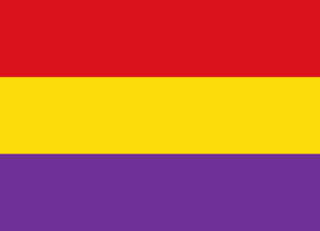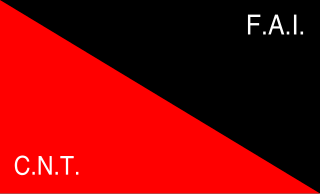In 1937, the Nationalists, under the leadership of Francisco Franco began to establish their dominance. An important element of support was their greater access to foreign aid, with their German and Italian allies helping considerably. This came just as the French ceased aid to the Republicans, who continued, however, to be able to buy arms from the Soviet Union. The Republican side suffered from serious divisions among the various communist and anarchist groupings within it, and the communists undermined much of the anarchists' organisation.

The 9th Panzer Division was a panzer division of the Wehrmacht Army during World War II. It came into existence after 4th Light Division was reorganized in January 1940. The division was headquartered in Vienna, in the German military district Wehrkreis XVII.
The Durruti Column, with about 6,000 people, was the largest anarchist column formed during the Spanish Civil War. During the first months of the war, it became the most recognized and popular military organisation fighting against Franco, and it is a symbol of the Spanish anarchist movement and its struggle to create an egalitarian society with elements of individualism and collectivism. The column included people from all over the world. Philosopher Simone Weil fought alongside Buenaventura Durruti in the Durruti Column, and her memories and experiences from the war can be found in her book, Écrits historiques et politiques. The Durruti Column was militarised in 1937, becoming part of the 26th Division on 28 April.

The Iron Column was a Valencian anarchist militia column formed during the Spanish Civil War to fight against the military forces of the Nationalist Faction that had rebelled against the Second Spanish Republic.
The British Battalion was the 16th battalion of the XV International Brigade, one of the mixed brigades of the International Brigades, during the Spanish Civil War. It comprised British, Irish, and Dominion volunteers.

The Battle of Santander was a battle fought in the War in the North campaign of the Spanish Civil War during the summer of 1937. Santander's fall on 26 August assured the Nationalist conquest of the province of Santander, now Cantabria. The battle devastated the Republic's "Army of the North"; 60,000 soldiers were captured by the Nationalists.

The 216th Infantry Division was a German Army division that was created during the Second World War; it was active from 1939–1943. It served on the Western Front in 1940 and later took part in the Eastern Front campaign, being involved in the disastrous Battle of Kursk.
The Isaac Puente battalion was a battalion of the Confederación Nacional del Trabajo (CNT) from the Basque Country which was active during the Spanish Civil War from September 1936 to October 1937. It was named after Isaac Puente and was nº 3 of the Milicias Antifascistas de la CNT and nº 11 of the Euzko Gudarostea. The battalion participated in the Villarreal Offensive, the Vizcaya Campaign, the Battle of Santander, the Asturias Campaign and the Battle of El Mazuco.

The 175th Mixed Brigade, was a mixed brigade of the Spanish Republican Army in the Spanish Civil War. Its number was formerly corresponding to the 10th Santander Brigade, a unit operating in Santander, Spain but was assigned to a new unit in the spring of 1938 in Valencia Province and had four battalions, 697, 698, 699 and 700.

The confederal militias were a movement of people's militia organized during the Spanish civil war by the dominant organizations of anarchism in Spain: the National Confederation of Labor (CNT) and the Iberian Anarchist Federation (FAI).
The Land and Freedom Column was a militia column organized by the CNT-FAI from the regions of Berguedà and Bages as well as from Barcelona. The column was sent to the Central front in mid-September 1936 to reinforce the republican line against a nationalist force that was entering Talavera de la Reina and besieging Toledo, thereby threatening Madrid. It had around 1,500 militiamen in its beginnings, participating in the fronts of the Sierra de Gredos and Sierra de Albarracín. The column integrated into the Rosal Column and later fought on the Serra de Montsant front. After the militarization that occurred in the spring of 1937, the column became the 153rd Mixed Brigade.
The Rosal Column was a republican militia column created during the Spanish Civil War, it was made up of anarchists from the National Confederation of Labor (CNT). They fought in the central zone.
The 39th Mixed Brigade was a unit of the Spanish Republican Army that took part in the Spanish Civil War. Throughout the war the brigade was present on the Madrid, Guadalajara and Levante fronts.
Eusebio Sanz Asensio was a Spanish anarchist and military commander.
The 183rd Mixed Brigade - originally created as the 3rd Asturian Brigade - was one of the mixed brigades created by the Spanish Republican Army for the defense of the Second Spanish Republic.
The XVI Army Corps was a military formation of the Spanish Republican Army that fought in the Spanish Civil War. It had an outstanding performance in the Levante campaign.
Fervenza Francisco Fernández was a Cantabrian anarcho-syndicalist.
The 98th Mixed Brigade was a unit of the People's Army of the Republic created during the Spanish Civil War. Throughout the war it came to operate on the Madrid, Guadalajara and Levante fronts.
The 140th Mixed Brigade was a unit of the Spanish Republican Army created during the Spanish Civil War. Throughout the war it operated on the fronts of Aragon, Segre, Ebro and Catalonia.
The 71st Mixed Brigade was a unit of the Spanish Republican Army that participated in the Spanish Civil War, deployed on the Guadalajara front.





